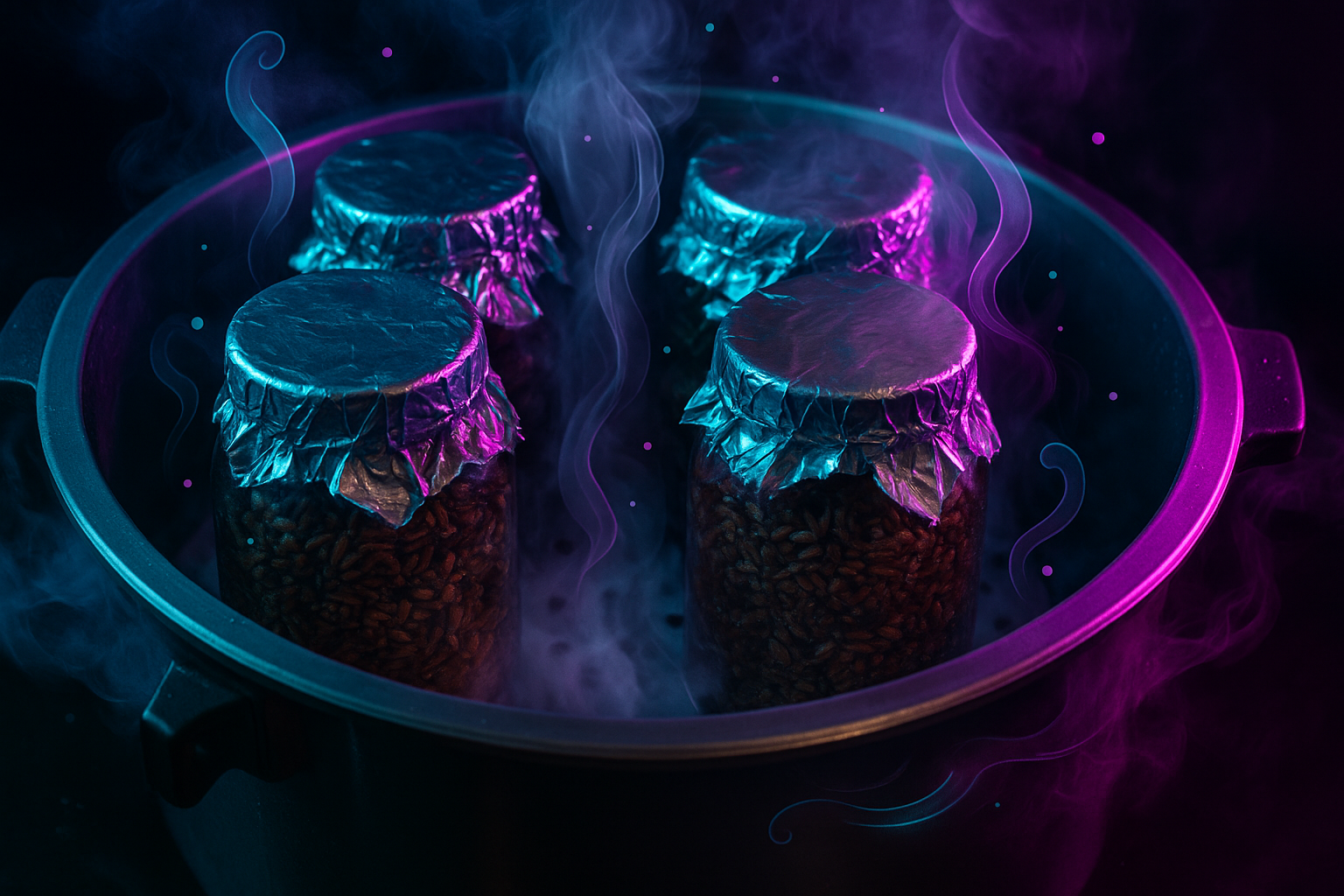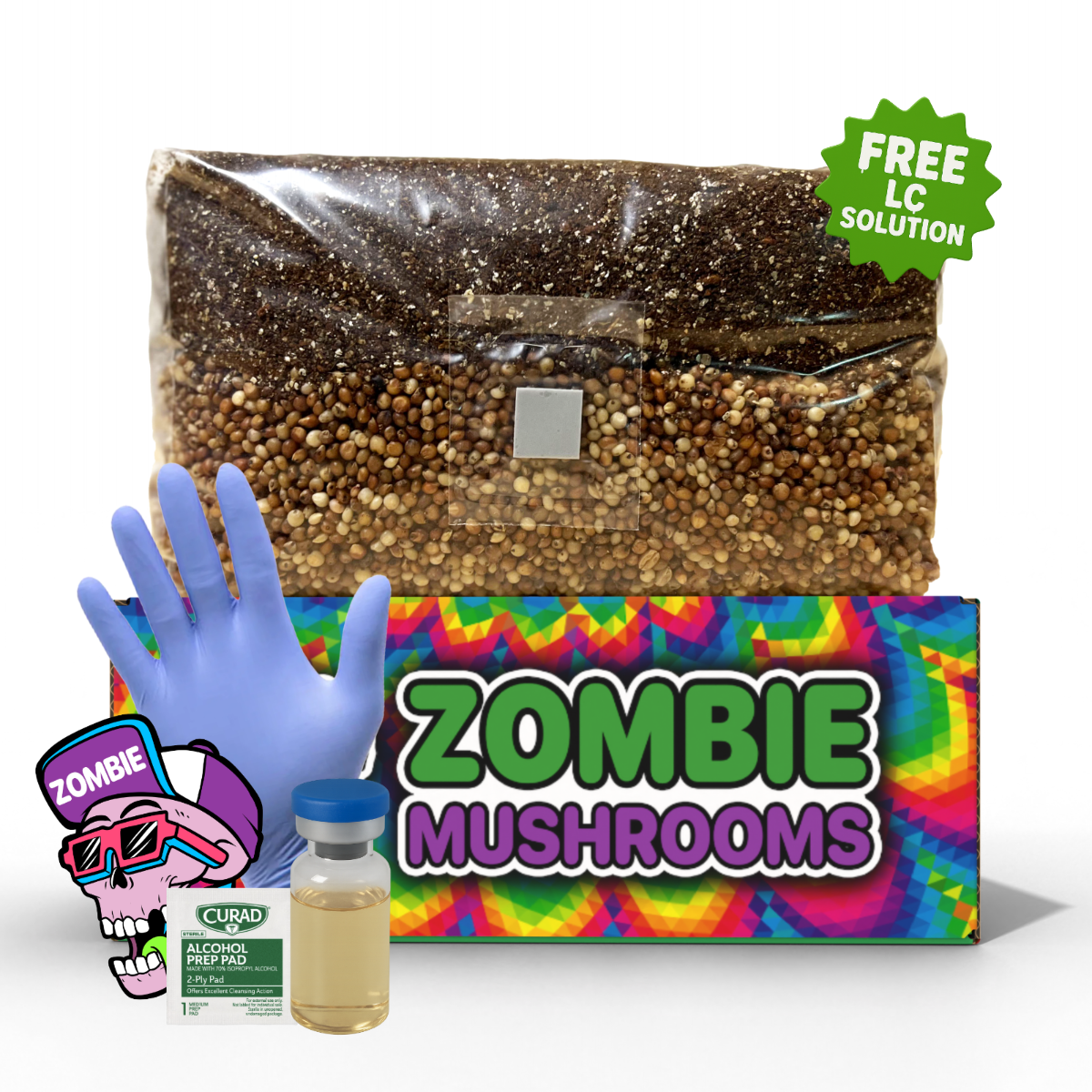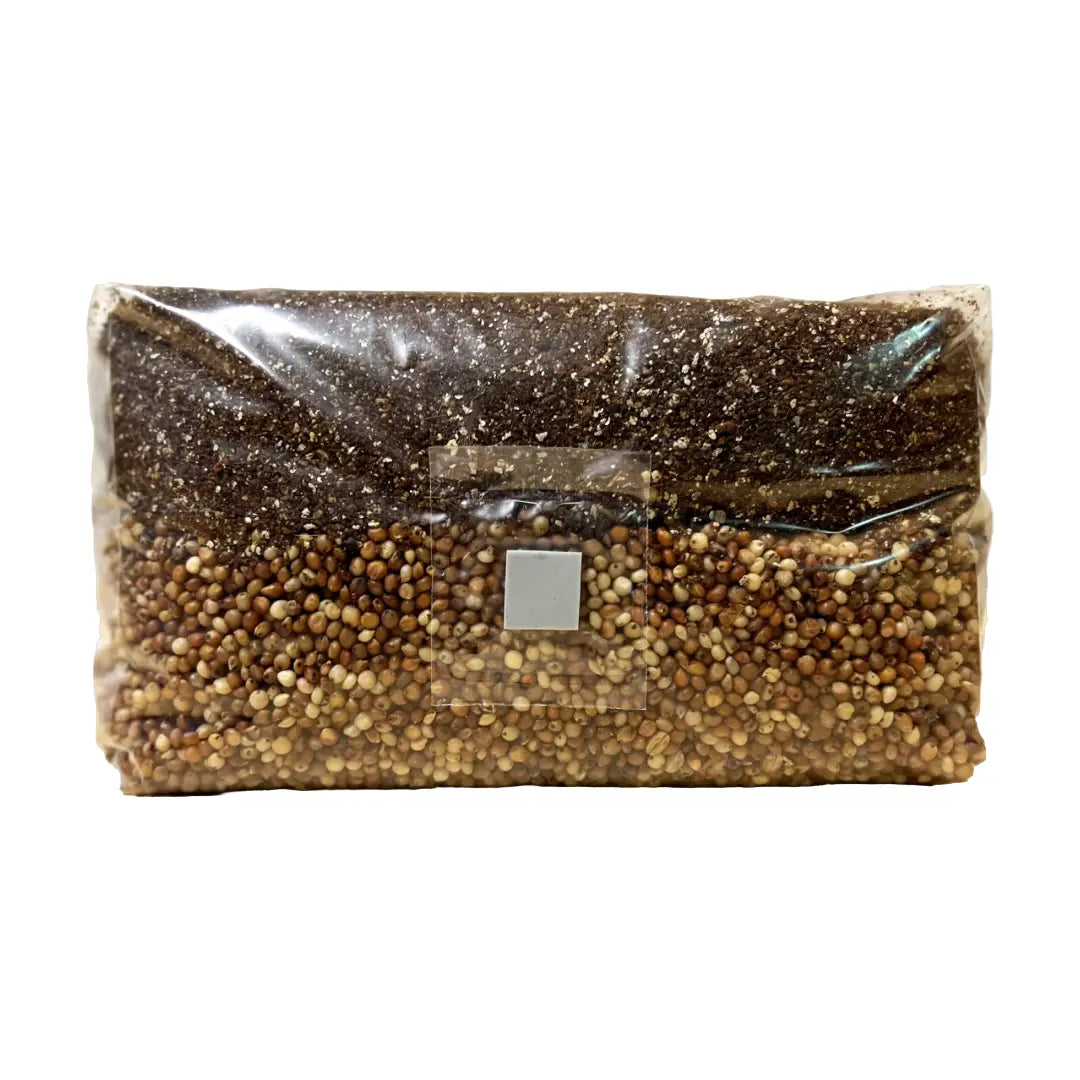⬇️ Prefer to listen instead? ⬇️

- 🔬 Sterilization removes 100% of microorganisms, while pasteurization only reduces them.
- 🍄 High-nutrient substrates like supplemented sawdust require sterilization due to high contamination risk.
- ⚗️ Using a pressure cooker allows reliable sterilization by reaching 121°C at 15 PSI.
- 🔥 Atmospheric steam methods can sterilize without pressure but take 10–12 hours to complete.
- 🧪 Exotic or slow-growing mushrooms like shiitake and lion's mane demand sterile substrate to prevent failed colonization.

Mushroom Substrate Sterilization: Is It Necessary?
Contamination often causes mushroom grows to fail, especially for new growers. This often happens because the substrate is not clean enough before inoculating Mushroom Grow Bags or preparing a Monotub. You might be growing fast fruiters like oyster mushrooms, or you might grow more sensitive gourmet types like lion’s mane. Either way, you need to know when and how to sterilize mushroom substrate. This guide explains when substrate sterilization is needed, how to do it well—especially with a pressure cooker—and highlights how tools like autoclave tubing can help make the process safer and more effective.

What Is Mushroom Substrate Sterilization?
Mushroom substrate sterilization fully removes all microbial life from a growing medium. This means bacteria, mold spores, competing fungi, viruses, and protozoa are all gone. A sterile environment gives mushroom mycelium a good start. It removes other organisms that could eat available nutrients or take over the new spawn.
Pasteurization usually heats substrate to 60–80°C (140–176°F). This kills many harmful organisms. But sterilization needs ongoing high heat. It usually reaches 121°C (250°F) at 15 PSI. This kills everything, even spores that resist heat and bacteria that can handle high temperatures.
Making the substrate completely free of life is very important. This is true when you use nutrient-rich substrates. Examples are sawdust with bran, coffee grounds, or grain spawn. These substrates can easily get contaminated if they are not sterilized correctly.

Does Mushroom Substrate Really Need to Be Sterilized?
The short answer: sometimes. Whether you need to sterilize depends on a few key things:
1. Mushroom Species
- Fast colonizers like oyster and enoki mushrooms often grow on low-nutrient substrates quicker than other microbes. This means pasteurization is usually enough.
- Slow-growing or sensitive species such as shiitake, lion’s mane, or reishi need sterilization. This is because they grow slower and can more easily be overtaken by other organisms (Royse et al., 2017).
2. Substrate Type
- Materials with high nutrients (like grain spawn, coffee grounds, or sawdust with added supplements) are good places for bacteria and mold to grow. So, these need sterilization.
- Substrates with low nutrients like straw, wood chips, and coco coir are less likely to get contaminated. They often do well with pasteurization.
3. Environmental Conditions
- If your grow area is humid and not sterile, contaminants can spread more easily. This makes full sterilization more important.
- Growers in cleaner, more controlled areas might only need pasteurization, depending on the substrate.

Sterilizing vs. Pasteurizing Mushroom Substrate: What's the Difference?
It is important to know the difference between these two methods for successful growing. Both have benefits and clear uses.
| Feature | Pasteurization | Sterilization |
|---|---|---|
| Temperature | 60–80°C (140–176°F) | 121°C (250°F) or higher at 15 PSI |
| Microorganism Kill Rate | Partial (kills many competitors, not all) | Complete (kills all microbes and spores) |
| Time Required | 1–2 hours (depending on method) | 1.5–2.5 hours using a pressure cooker |
| Equipment Needed | Hot water bath, lime soak, or cooler | Pressure cooker, autoclave, or steam tunnel |
| Ideal For | Straw, coco coir, manure, fast growers | Grain spawn, enriched sawdust, exotic species |
Key Takeaway: Use pasteurization for simple, low-cost setups. Use sterilization when growing gourmet mushrooms, trying new setups, or working with high-nutrient mediums.

Which Substrates Need Sterilization?
Here are some common mushroom-growing substrates. They should be sterilized to lower the risk of contamination:
1. Grain Spawn
Grains like rye berries, millet, popcorn, wheat, and sorghum have many nutrients. This makes them very likely to get contaminated. You must sterilize them before adding mushroom culture.
2. Sawdust with Added Nutrients
Growers often put bran, wheat germ, or soy hulls into sawdust blocks to get more mushrooms. This makes the blocks richer in nutrients for the mushrooms. But it also feeds other microbes that compete with the mushrooms. So, you should only use sterilized blocks for species like shiitake or reishi.
3. Coffee Grounds
Coffee grounds are a popular, sustainable choice. They have a lot of nitrogen and organic matter. This makes them a good place for bacteria to grow. You need to fully sterilize coffee grounds if you use them.
4. Compost or Manure Mixes
Rich composts are often used to grow portobello or button mushrooms. These might be pasteurized for some mushroom types. But they need sterilization if they have many added nutrients or are kept in very humid places.

How to Sterilize Mushroom Substrate Using a Pressure Cooker
For home and small-scale growers, using a pressure cooker is the best way to sterilize mushroom substrate.
Step-by-Step Process
-
Prepare Your Substrate
-
Load the Pressure Cooker
-
Vent Well
- Turn up the heat. Let steam escape for 10 minutes before you seal the cooker. This makes sure all air is out and pure steam fills the chamber. This is very important to reach 121°C.
-
Get to Pressure and Hold Time
- Clamp the lid. Bring the pressure up to 15 PSI. Start your timer:
- For jars or small bags: 90 minutes
- For large blocks or very dense materials: 2 to 2.5 hours
- Clamp the lid. Bring the pressure up to 15 PSI. Start your timer:
-
Cool Down Fully
- After the time is up, turn off the burner. Let the cooker cool down on its own to room temperature. Do not open the valves. If you release pressure too fast, bags might break. Or airborne contaminants might get sucked in.
-
Move in Clean Conditions
- Work in a still-air box or in front of a laminar flow hood. This is where you will add spawn to your sterile substrate.

Best Ways to Sterilize Mushroom Substrate with a Pressure Cooker
- 🛑 Don't put too many items in the cooker. Steam needs enough room to move around.
- ✅ Always vent first. This step is very important, but people often forget it.
- 💧 Don't let water boil away while it is working. Check water levels before you start.
- ❄️ Let things cool completely. If you open the cooker while it is still under pressure, contaminants can get sucked in.
- 🪞 You might want to wrap bags loosely in aluminum foil. This helps protect filter patches from water drips during sterilization.
- 🔒 Check the pressure valve and seals every time you use the cooker. This is for your safety.
 How to Sterilize Mushroom Substrate Without a Pressure Cooker
How to Sterilize Mushroom Substrate Without a Pressure Cooker
You can try to sterilize or nearly sterilize substrates without pressure. But these ways are not as good. They are not suggested for materials that easily get contaminated.
1. Boiling Water Bath
- Put jars or bags into a pot of boiling water for 60–90 minutes.
- Make sure bags are sealed with heat. And lift them so they are not fully under water.
- This works best for grain in jars or small amounts of sawdust logs.
2. Oven Sterilization
- Heat your oven to 250°F (121°C).
- Put filled jars or bags on an oven tray. Leave lids a bit loose so pressure does not build up.
- Bake for 2–4 hours.
- Use an oven thermometer to keep the heat exact.
3. Steaming without Pressure
- This method was made for mushroom farms that did not have autoclaves.
- Use a metal drum with trays raised above the water line. Fill the drum with water below the trays.
- Steam for 10–12 hours straight. Keep the lid tightly closed.
- This is hard work but it works well if done right (Griensven, 1988).
4. “Bag-in-a-Pot” Steaming
- Put grow bags in a large pot with a metal stand. Steam for 8–10 hours.
- This works for do-it-yourself large batches of sawdust blocks with added nutrients.
⚠️ These methods cannot fully sterilize, especially against tough bacterial spores. But they can work in places with few contaminants or with the right spawn.
How Long Does Substrate Sterilization Take?
The time needed changes based on the method and how dense the substrate is:
| Method | Time Required |
|---|---|
| Pressure Cooker (15 PSI) | 90 minutes to 2.5 hours |
| Boiling Water Bath | ~90 minutes |
| Oven (250°F) | 2–4 hours |
| Atmospheric Steam | 10–12 continuous hours |
| Cold sterilization (lime/lime soak) | 12–24 hours, not true sterilization |
If you can, always check the temperature inside the substrate. This is very important for large blocks. It helps make sure the heat is even all through the material.
Common Mistakes to Avoid When Sterilizing Mushroom Substrate
- ❌ Rushing the venting process.
- ❌ Not sterilizing long enough.
- ❌ Packing substrates too tightly.
- ❌ Opening the cooker while it is still hot.
- ❌ Not wearing gloves or masks when you handle sterilized substrate.
If you avoid these mistakes, you will have a much better chance of healthy mushroom growth and many flushes.

Good and Bad Points of Full Substrate Sterilization
✔ Good Points:
- It removes almost all contamination dangers (99.999%).
- You can use nutrient-rich substrates that give a lot of mushrooms.
- This is a must for rare or medicinal mushroom types.
- It gives more steady results for growing mushrooms on a larger scale.
✖ Bad Points:
- You need special equipment like a pressure cooker or autoclave.
- It uses up fuel or electricity.
- If you are not careful when sterilizing, you can still get contamination.
- You need to learn how to use the equipment safely.

When Pasteurization Is Good Enough
Pasteurization is a good choice for:
- Mushroom types that are easy for beginners to grow, like oyster or pink oyster mushrooms.
- Growing large amounts using straw, wood chips, or manure.
- Growers who do not have a pressure cooker. They can use simple methods like lime pasteurization.
Methods such as bucket pasteurization (using boiling water) or hydrated lime soaks (a cold method) are cheap and work well for these substrates.

How to Pick the Right Sterilization Method for Your Grow
Picking between sterilization and pasteurization is not just about your equipment. It is about matching the method to your substrate and mushroom type:
| Grow Type | Recommended Method |
|---|---|
| Oyster mushrooms on straw | Pasteurization (hot water) |
| Lion's mane on sawdust + bran | Sterilization (pressure cooker) |
| Beginners without equipment | Pasteurization (lime or boiling water) |
| Medicinal mushroom blocks | Steam or pressure sterilization |
| Experimental species | Sterilization (controlled environment) |
If you want more mushrooms, want to grow rare types, or want to have fewer failures, putting money into pressure sterilization is very much worth it.
Sterilization Supplies and Ready-to-Use Options
Some growers want to avoid doing it themselves and avoid mistakes. For them, companies like Zombie Mushrooms sell pre-sterilized grain spawn bags, substrate blocks ready to use, and mushroom grow kits. These can save time. They also cut down on problems for new growers. And they help more grows turn out well.
Citations
Royse, D. J., Baars, J., & Tan, Q. (2017). Specialty Mushrooms: Cultivation and Market Potential in the United States. Horticultural Reviews, 45, 199–213.
Stamets, P. (2000). Growing Gourmet and Medicinal Mushrooms (3rd ed.). Berkeley, CA: Ten Speed Press.
Chang, S. T., & Miles, P. G. (2004). Mushrooms: Cultivation, Nutritional Value, Medicinal Effect, and Environmental Impact. CRC Press.
Griensven, L. J. L. D. van (Ed.). (1988). The Cultivation of Mushrooms. Darlington Mushroom Laboratories.
Disclaimer: This guide is for educational purposes. Always follow safety protocols when handling high-pressure equipment.



